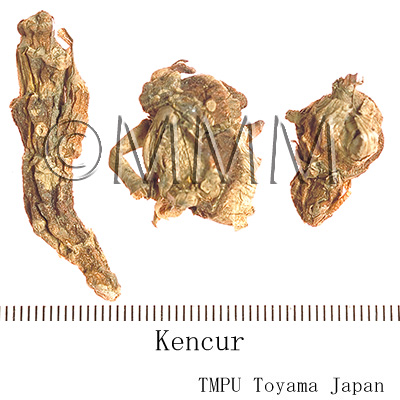Crude drug sample data base
※Click on the image to enlarge it.
Scientific information data base
| Crude drug name | Indonesian name, English name | Kencur, Lesser galangal | ||||
|---|---|---|---|---|---|---|
| crude drug image |
| |||||
| Original plant name | Kaempferia galanga Linn. | |||||
| Family name | Zingiberaceae | |||||
| Used part | Rhizome, roots, seeds | |||||
| Distribution area | It grows wild and now is cultivated in Java (Indonesia). | |||||
| Description | It is an Indonesian rhizome that looks a bit like ginger but smaller and darker. It has a dark reddish-brown skin and the soft interior is nearly white. It has strong spicy aroma [201]. The plant is a herb; stem with 2-3 leaves, 10 cm wide and has a red edge [222]. | |||||
| Drug effect | Hot, warming [231]. | |||||
| Specific actions | Carminative, expectorant, analgesic [231]. | |||||
| Frequency in use | Abundant | |||||
| Common uses | It is mainly used as a spice in various Indonesian side dishes. Sundanese people eat the young underground parts and the leaves raw as ''lalab'' . It is sold fresh, dried or powdered [201, 222]. | |||||
| Pharmacological effect | The rhizome is reported to display cytotoxic properties. Crude dichlormethane extract of Kaempferia galanga showed a potent bioactivity in brine shrimp lethality test. Intravenous administration of the extract induced a dose-related reduction of basal mean arterial pressure in the anaesthetized rat, with maximal effects seen after 5-10 min of injection. The gas chromatogram showed that the common compound in the active fractions obtained from the bioassay-guided fractionation of the CH[2]Cl[2] extract was ethyl cinnamate [PMID:16360934]. The -cis and -trans ethyl-p-methoxycinnamate isolated from Kaempferia galanga has inhibitory effect in vitro, and has inhibitory effects in TPA tests or croton oil-induced ear edema, ornithine decarboxylase activity in specimen of mouse epidermis and extent of papilloma, indicating a relatively strong anti-carcinogenic potential of ethyl-p-methoxycinnamate [PMID:12600030]. The ethanolic rhizome extract of Kaempferia galanga L. (Zingiberaceae) was studied by conventional pharmacological methods including the Hippocratic screening test, and acute and subacute toxicities in rats. Pathologically, neither gross abnormalities nor histopathological changes were observed. No sign of irritation was observed during the dermal irritation test of the hexane fraction of Kaempferia galanga [PMID:15013202]. From the rhizomes of Kaempferia galanga, ethyl cinnamate was isolated and its vasorelaxant effect was examined on the rat aorta. EC inhibited the tonic contractions induced by high K+ and phenylephrine (PE) in a concentration-dependent manner, with respective IC50 values of 0.30 +/- 0.05 mM and 0.38 +/- 0.04 mM. Result showed that the vasorelaxant effect of ethyl cinnamate mediated through multiple pathways may explain the traditional use of the parent plant in treating hypertension [PMID:12143006]. | |||||
| Medical system | Indonesian medicine (Jamu) | |||||
| Traditional usage | Externally it is rubbed to treat inflammations, rheumatism and to warm the abdomen [201]. Indonesian women, including Javanese women, are very fond of the rhizome because of its warming property, especially in using it externally for stomach ache. Juice obtained from squeezed rhizome is used as an expectorant. In some recipes, the rhizome is used to treat stomachache [201]. The rhizome is one of the main components in an extremely popular Indonesian traditional drink namely ''beras kencur'' (beras = rice, kencur = rhizome of K. galanga). The drink is used for tiredness, refreshing the body, for strength, recovery of the womb. It is used to cure coughs and release stomach gas. Fresh roots are crushed, mixed with seeds of Myristica fragrans to make a porridge-like substance and is used to treat ear infections with pus. Sap obtained from squeezed porridge is applied to the ear internally [201]. | |||||
| Formulation | 1) Cough: 15 grams of fresh grated rhizome is squeezed by adding some water, strain to make 50 ml of juice. Drink 2 tablespoons of the juice twice a day for 14 days. One teaspoon or one tablespoon for children [231]. | |||||
| References | Reference book Tips! | [201] K. Heyne, Tumbuhan Berguna Indonesia, Vols. 1-4, 1987. Diedarkan Oleh Koperasi Karyawan Departemen Kehutanan, Jakarta, Indonesia. Vol. 1, p 592. [222] P.T. Eisai Indonesia: Medical Herb Index in Indonesia (Second edition).1995. pp 274. [231] Soedibyo, Mooryati: Alam Sumber Kesehatan: Manfaat dan Kegunaan (Natural resources for health. Benefits and uses). Balai Pustaka. 1998. pp 215-216. | ||||
| Research paper | 1. Othman R, Ibrahim H, Mohd MA, Mustafa MR, Awang K. Bioassay-guided isolation of a vasorelaxant active compound from Kaempferia galanga L. Phytomedicine., 13(1-2):61-6, 2006. (PMID: 16360934) 2. Kanjanapothi D, Panthong A, Lertprasertsuke N, Taesotikul T, Rujjanawate C, Kaewpinit D, Sudthayakorn R, Choochote W, Chaithong U, Jitpakdi A, Pitasawat B. Toxicity of crude rhizome extract of Kaempferia galanga L. (Proh Hom). J Ethnopharmacol., 90(2-3):359-65, 2004. (PMID: 15013202) 3. Xue Y, Chen H. Study on the anti-carcinogenic effects of three compounds in Kaempferia galanga L. Wei Sheng Yan Jiu., 31(4):247-8, 251, 2002. (PMID: 12600030) 4. Othman R, Ibrahim H, Mohd MA, Awang K, Gilani AU, Mustafa MR. Vasorelaxant effects of ethyl cinnamate isolated from Kaempferia galanga on smooth muscles of the rat aorta. Planta Med., 268(7):655-7, 2002. (PMID: 12143006) | |||||
| Last renewal date | 2024/03/08 | |||||






